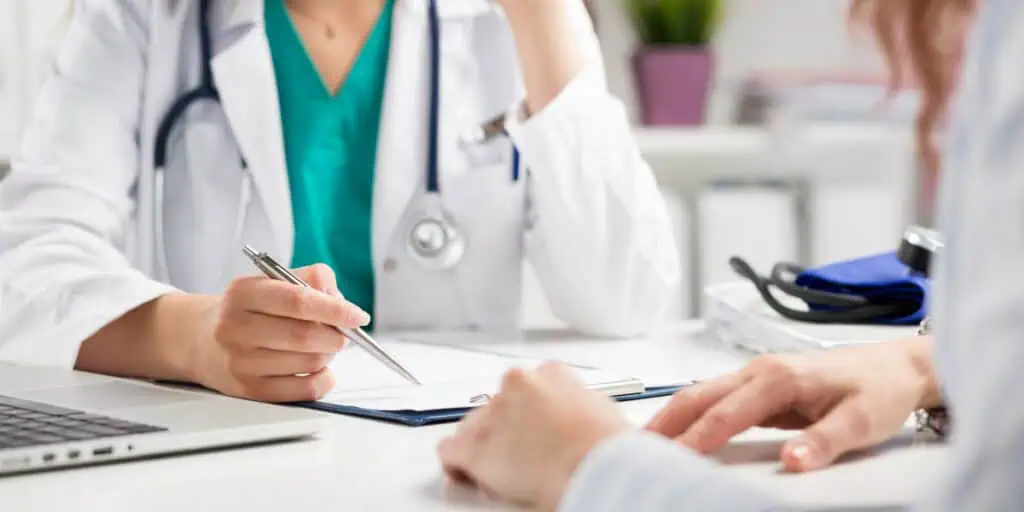When Olivia Munn came forward with her breast cancer diagnosis and double mastectomy, she kick-started a much-needed conversation about breast cancer risk assessments.
Everyday Health used this opportunity to discuss breast cancer risk assessment tools and their role in helping women take control of their own health.

Breast Cancer Risk Assessment Tools: Should You Use One?
When the actor Olivia Munn credited a diagnostic tool many had never heard of for catching her breast cancer, thousands turned to breast cancer risk assessment websites to see what they were about.
Many clinicians think that’s a good thing.
The assessment tool Munn used was essentially a question-and-answer survey that calculated her lifetime risk of breast cancer on the basis of known risk factors like age at the birth of a first child. Munn’s results revealed her to be at high risk for breast cancer — even though she’d recently received a clean mammogram and negative results on genetic screening for high risk cancer genes.
Munn’s doctor, Thaïs Aliabadi, MD, a board-certified obstetrician-gynecologist in Beverly Hills, California, and a cohost of the SHE MD Podcast, thought that was enough reason to order an MRI (magnetic resonance imaging) and an ultrasound. Those tests led to a biopsy that revealed an aggressive form of breast cancer, luminal B breast cancer, that would have otherwise remained undetected for at least another year.

The news lit up the internet, not only because Munn is a celebrity, but because it shed light on a tool that most women didn’t know existed.
For physicians like Lisa Curcio, MD, a breast surgeon in Rhinebeck, New York, and a breast cancer survivor, the story underlines the power of risk assessment in early diagnosis.
Everyday Health asked Dr. Curcio what women need to know about these tools.
Everyday Health: What are cancer risk assessment tools?
Lisa Curcio: They’re questionnaires that weigh multiple risk factors and assign a numerical value, expressed as a percentage, to an individual’s likelihood of developing breast cancer. They follow a question-and-answer format that incorporates factors such as personal genetics, family cancer history, reproductive and breast health background, previous medical issues, and lifestyle factors to calculate an overall risk score.
EH: So there are more than one?
LC: Roughly a half-dozen of these surveys exist, each unique in the breadth and depth of information collected.
Both the Gail model and the Tyrer-Cuzick or IBIS, use a question-and-answer format to incorporate such factors as menstrual history, age of first live birth, history of previous breast biopsies, density on mammogram, and family history.
The Gail model is believed to potentially underestimate risk, since it doesn’t go into as much depth on genetic history. Some providers prefer the IBIS, and other rely on different questionnaires. The responses generate an overall score that physicians can use to estimate risk and order testing. The goal is to provide a diagnosis at the earliest possible stage to ensure the best prognosis.
EH: How is the risk calculated?
LC: Some surveys consider immediate, or first-level family members who’ve had breast, reproductive, and other cancers. Others also include cancers among more distant relatives. They all usually query the individual’s age at first menstruation, the age at which the person gave birth (if at all), the person’s use of birth control pills or hormone replacement therapy, any previous breast biopsies that revealed atypical cells, and general health.
Some assessments, such as one recommended by the American College of Obstetrics and Gynecology, track an individual’s smoking and drinking habits and physical activity level; this test also considers prior exposure to high-dose therapeutic chest irradiation in young women (ages 10 to 30).
Poor dietary habits, obesity, a sedentary lifestyle, and the presence of dense breast tissue — which affects about 40 percent of women — tend to increase risk. Breast density is a strong risk factor and is tracked in the IBIS model.
Most also track previous exposure to chest radiation (as in treatment for Hodgkin’s lymphoma); an individual’s smoking and drinking habits; physical activity level; and general lifestyle. Poor dietary habits, obesity, a sedentary lifestyle, and the presence of dense breast tissue — which affects about 40 percent of women — tend to increase risk.
EH: How do you interpret your result?
LC: The average American woman’s risk hovers around 10 or 11 percent. A 20 percent finding is labeled “low high risk,” while a score of 30 percent to 50 percent falls into the “high-risk” category. Anything exceeding 50 is considered very high risk and the individual requires additional attention.
EH: Are you happy that this case has generated heightened interest in these tools?
LC: Yes. I was grateful in 2013 when Angelina Jolie announced that she carried a high-risk BRCA gene that predisposed her to cancer, because it introduced the world to genetic testing and mutations. I feel that Olivia Munn is focusing similar attention on the importance of breast cancer risk screenings. When a high-profile person shares a personal story like this, it sends a powerful message.
EH: Should everyone know their breast cancer risk score?
LC: I think they should. I’d like to see everyone have an initial risk assessment in their twenties. Along with that, younger women should learn to be proactive, understand how to examine their breasts, and become familiar enough with them to note any future changes.
EH: Do many doctors already use them, unbeknownst to us?
LC: In my practice, and many others, regardless of the reason for a doctor visit, a nurse or medical assistant writes up all the risk factors (or, in many practices, this is done on intake forms) and, using an assessment questionnaire, calculates a risk score before I walk into the examination room. That way, I can talk about it from the start.
EH: The current screening tools include the modified Gail model/Breast Cancer Risk Assessment Tool (BCRAT); the Breast Cancer Surveillance Consortium (BCSC) model; the Rosner–Colditz model; the Tyrer–Cuzick (International Breast Intervention Study/IBIS) model; the Myriad model, which includes at BRCA mutations; and the Black Women’s Health Study calculator. Which do you use?
LC: We use the Tyrer–Cuzick or IBIS model, which I find the most sophisticated. It includes the age of first menstruation, the first live birth, hormone use, previous breast biopsies, and suspicious results, as well as breast density, family history beyond first-degree relatives, and cases of other cancers. The Gail model is more popular but less extensive.
EH: How important is it for people to do this kind of assessment with a medical professional, rather than on their own?
LC: It’s essential to work with a medical professional. The subtleties of the surveys, the need for accurate data entry, and the possibility of omission can make it tricky to do alone. Not all surveys go into adequate depth on family history, and many are based on a predominantly white population. They may not be as precise for Black Americans or other groups.
EH: What happens after you know someone’s risk score?
LC: Once the number reaches 20 percent — two times the average — this “low high risk” category calls for increased attention.
In that case, we’ll take a closer look at family history, discuss other forms of screening, or consider beginning diagnostics — such as mammograms—sooner than the suggested age of 40. If the individual has a close relative who developed the cancer at a young age, we’ll begin screening 10 years earlier than that age of onset.
We discuss lifestyle changes — getting to a healthier body weight, starting a regular exercise program, following a healthy diet, cutting out alcohol and tobacco.
At 25 percent risk, we discuss other strategies. We may opt for every six months screenings, alternating between a mammogram (3D or regular) and ultrasound, or we may call for MRIs.
If a woman has dense breasts, we order sonograms in addition to mammography, and make sure insurance covers the extra imaging.
EH: What are some options for those with very high risk scores?
LC: Drugs and preventive surgery are offered to those at high risk.
Tamoxifen, widely used to treat breast cancer, reduces breast cancer risk by 50 percent in clinical trials. Choosing drug prevention is a very personal decision based on an individual’s risk tolerance, however. Tamoxifen, for instance, increases the risk of uterine cancer and can promote the formation of blood clots, which can be deadly if they travel to the lungs.
Surgery to remove the breasts — prophylactic mastectomies — is effective for people at the highest risk. It achieves a 95 percent reduction in the odds of developing breast cancer. But it’s a major operation, particularly when some women choose to remove their reproductive organs, too, as Angelina Jolie did.
EH: Munn’s mammogram missed her cancer. Does her story raise any red flags about the accuracy of mammography?
LC: No. I don’t believe anything can currently replace mammography for the general population and mammography and ultrasound for higher-risk patients. Other screenings come with their own issues. Breast MRIs, for example, can require intravenous infusion of contrast dye, which has its own risks, and the test tends to yield a greater number of false negative results.
EH: How did your experience with breast cancer at age 37 affect your clinical practice?
LC: In some ways, my breast cancer was a blessing. It altered the direction of my career from general surgical oncology to breast cancer surgery. And that has become my calling, both as a physician and as an advocate for prevention. Today, 96 percent of breast cancers that are found with mammograms before they can be felt are curable. I’m hoping that, eventually, I won’t have to treat breast cancer at all. I’ll only prevent it.
Read the whole article by Susan Treiman on EveryDayHealth.com.
Make Dr. Aliabadi your Los Angeles OB/GYN
A breast cancer survivor herself, Dr. Aliabadi is intimately familiar with the importance of understanding your risk and advocating for your own health. Along with her warm, compassionate team, Dr. Aliabadi provides medical care and support to women in every stage of their lives, from routine exams to pregnancy, childbirth, and menopause. If you have questions or concerns about your breast cancer risk, we invite you to reach out to Dr. Aliabadi and her expert team.
In addition to employing the latest cancer screening and prevention techniques, all diagnostic testing, labs, and treatments are performed in her office.
We invite you to establish care with Dr. Aliabadi. Please make an appointment online or call us at (844) 863-6700.
The practice of Dr. Thais Aliabadi is conveniently located for patients throughout Southern California and the Los Angeles area, near Beverly Hills, West Hollywood, Santa Monica, West Los Angeles, Culver City, Hollywood, Venice, Marina del Rey, Malibu, Manhattan Beach, and Downtown Los Angeles, to name a few.















